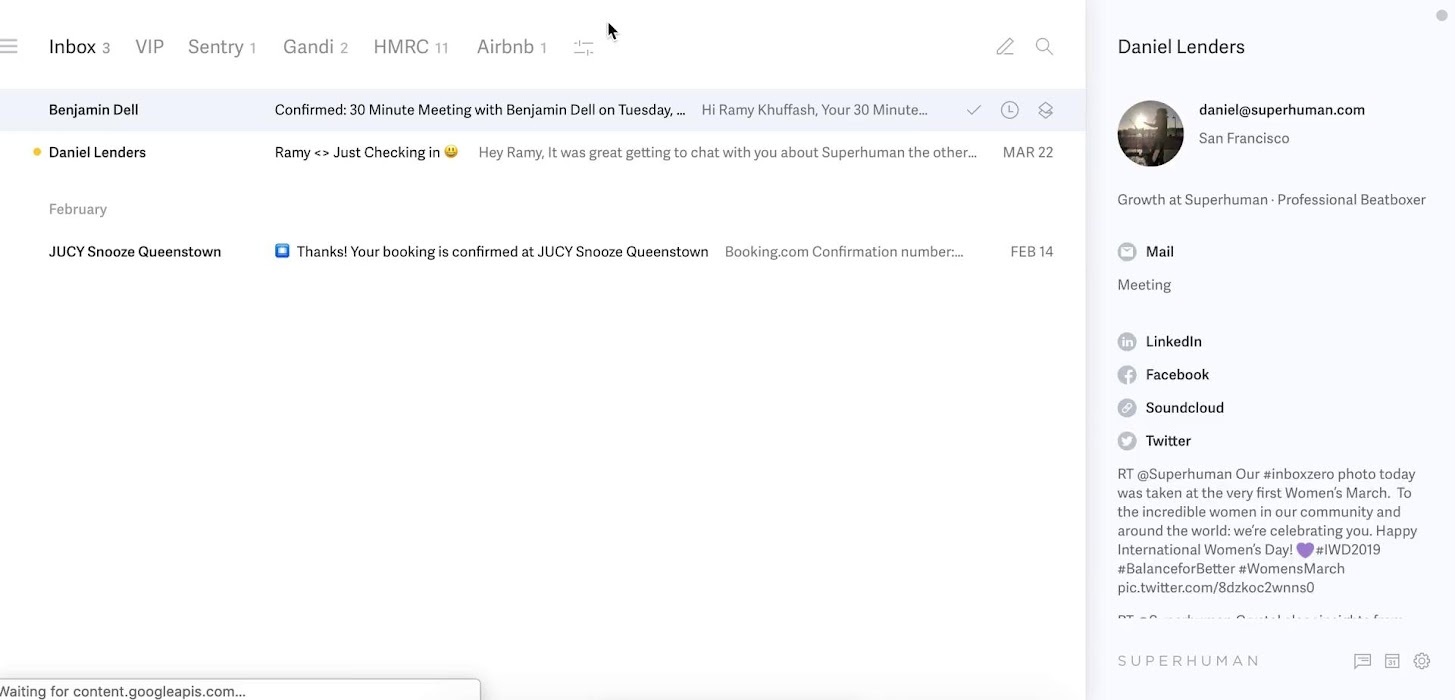TechRadar Verdict
Superhuman offers one of the most comprehensive features among email apps we’ve reviewed.
Pros
- +
Intuitive interface
- +
Scheduled emails
- +
Keyboard navigation
Cons
- -
Supports only Gmail
- -
Invite-only
- -
No Android app
Why you can trust TechRadar
In 2014, three entrepreneurs -- Rahul Vohra, Vivek Sodera, and Conrad Irwin -- teamed up to create an email client and productivity app in one for professionals and named their product Superhuman. They marketed it as an exclusive product available only through invites. Word spread, and Superhuman became a status symbol among young professionals who didn’t find a problem paying $30 per month for the privilege.
Over time, the team behind Superman built features targeted at enterprise users and marketed it successfully, luring big-name customers like Netflix, Airbnb, and Harvard University.
With over $100 million raised from venture capitalists, Superhuman is one of the most well-funded email startups.
Superhuman: Plans and pricing
A subscription to Superhuman costs $30 per month per user, making it one of the most pricey email tools. For reference, you can get a Netflix, Spotify, and Google One monthly subscription for that amount. Yet, thousands of users see it fit to pay that amount, and many more are on the waitlist.
The enterprise plan doesn’t have standard pricing. You’ll have to contact Superhuman’s sales team and negotiate a package.
Superhuman offers no free trial or a refund policy for users.

Superhuman: Features
Superhuman is a wrapper for the Gmail app with nice features to add. It’s not compatible with other email providers, which significantly limits its reach yet fosters the aura of exclusivity around the app. Its main functions are delivering speed and a visually appealing interface to make email communications more enjoyable. The app provides many features, including;
You can reply, search, and archive emails offline, and they’ll instantly sync when you come online. A slow network won’t disrupt your email activity when using Superhuman.
The sidebar of this app shows details on your contacts pulled from social media platforms like Twitter, Facebook, and LinkedIn and previous email conversations with that contact. The idea is to see what people look like, where they're based, and what they do.
This feature helps you expand your network by connecting with contacts on social platforms. For example, you should see a Connect button next to a contact’s LinkedIn details. Click on it, and it’ll automatically take you to the page where you’ll request a LinkedIn connection with that contact.
Ever noticed a typo just after sending an email and wanted to make corrections? The good thing is that you can do that thanks to Superhuman's Undo Send button. The button is present for a few seconds after sending an email, so click it, correct the errors, and resend it.
This feature isn’t so unique– it’s present in most modern email apps. Yet, it’s still one to highlight because of its usefulness.

Superhuman allows you to track whether recipients have read your messages so you can respond to them at the right moments. This feature is made possible by including tracking pixels (tiny, transparent images) not obvious to the recipient.
In its early days, Superhuman enabled this feature by default and spurred significant backlash and accusations of fostering a surveillance culture. The company later provided a remedy by allowing users to disable tracking pixels.
People are often too busy to reply to your emails, and it's easy to lose track of whether they've responded or not. To help users, Superhuman can send automatic follow-up emails. Just choose a time when sending an email, e.g., 3 days, and the app will remind you to follow up when due.
You can pick an exact time at which Superhuman will deliver your email to the intended recipient. For example, you can schedule an email for 8:55 am so that it'll be one of the first the recipient will see when they start their work day.
If your email is cluttered, you can declutter it by snoozing specific conversations, so that they won't appear in your inbox until the snoozing period is up. This feature helps you focus on what matters and have a more productive inbox.
Superhuman lets you use a combination of keyboard strokes to move quickly through your inbox. Every feature on the app is accessible through a keyboard shortcut, which makes navigation easier. For example, Ctrl + K inserts a link, and Shift + Ctrl + B adds BCC recipients.

Superhuman: Interface and use
As we’ve mentioned, one of Superhuman’s biggest strengths is its intuitive interface. It has a minimalist and premium feel that makes it enjoyable to interact with. It seems the platform's development team pored through every aspect of the interface to deliver a fine-tuned product.
You can download the Superhuman app on an iPhone or Mac desktop. It’s not available on Windows PCs or Android phones.
Superhuman: Support
There’s a dedicated support email where you can send inquiries or seek solutions to issues you encounter when using the app. There’s no live chat or telephone support, which we think isn’t fitting given the app’s high price.
Superhuman: The competition
The best alternative to Superhuman is Front, an app that integrates email with complementary features such as team collaboration and analytics. It has an appealing interface just like Superhuman and is more affordable, starting at $19 per month. However, it is best suited for enterprise use instead of individual usage like Superhuman.
Superhuman: Final verdict
Superhuman is an email app we’ll recommend to anyone willing to pay the steep price. Yet, the app is still invite-only, meaning being willing to pay isn’t sufficient. Being invite-only and exclusive to iPhones and Mac PCs is part of the premium branding, but we think that’s unnecessary gatekeeping.
Stefan has always been a lover of tech. He graduated with an MSc in geological engineering but soon discovered he had a knack for writing instead. So he decided to combine his newfound and life-long passions to become a technology writer. As a freelance content writer, Stefan can break down complex technological topics, making them easily digestible for the lay audience.

